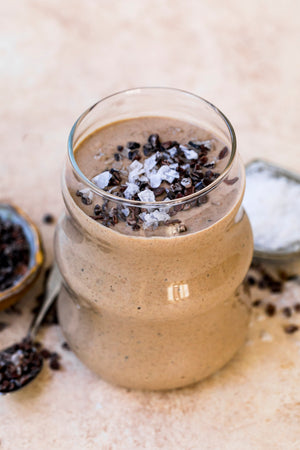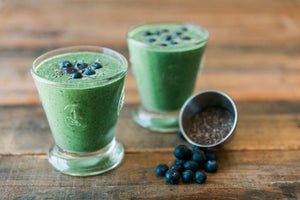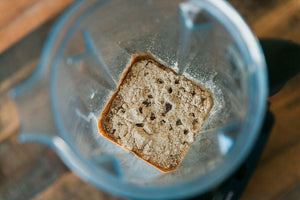I want to share how I’ve been naturally supporting mom and baby during postpartum – a season that is magical and blurry all at the same time.
It’s no surprise my go-to practices and products are right on brand. I focus on things that are minimal but powerful, attainable but impactful. When you’re sleep deprived, hungry, and nursing around the clock, you don’t need icing on the cake. You need foundational practices that keep your health anchored when days are foggy and nights are long.
Here’s what keeps me grounded, present and able to show up as my best self for my three boys (four - let’s not forget about Chris!):
Postpartum Nutrition
Pregnancy and birth leave me in awe of what a woman’s body is capable of doing. But all of that growing, stretching, supporting and expanding takes a toll, so it’s vital that postpartum nutrition be focused on increasing nutrient density in my meals for optimal healing.
I've been able to do this is by intentionally increasing the quantity and variety of vegetables I eat, incorporating more organ meat into my diet, and prioritizing home-cooked meals. One habit that has helped me increase the nutrient density of my meals is with weekly 'meal prep lite' of veggies and proteins so I can easily create nutrient-dense Fab 4 meals and satisfy my sweet tooth with a high-protein treat when the cravings hit.
- Increase Veggie Intake: Most of us know the importance of including a variety of plant-foods into our diet, but more often than not, we skip the one step that increases the quantity and variety of the veggies that we eat: WE DON'T PREP THEM! Then, we’re running late from a sport or the day gets away from us and it feels like a lot to make a homemade meal. But if our veggies can be easily thrown on a sheet tray, sautéed in a pan, or dropped onto a bed of lettuce… EVERYTHING CHANGES. I spend 20 minutes 1-2x times a week doing what I call ‘meal prep light’ after a weekly grocery shop to rinse, chop, and store my veggies in the fridge for easy access and it has been a game changer in how my whole family eats.
- What I do: After grocery shopping, wash and chop your fruits and veggies and store them in glass containers. If you have older veggies, now's a great time to throw them on a sheet pan to roast with some olive oil, salt, and pepper. Wash lettuce in the salad spinner and store in the fridge. Make a batch of homemade dressing you can use all week long. Try out this salad dressing hack to get pourable salad dressing from the fridge without any seed oils.
- Force of Nature Ancestral Blends: As someone who has struggled with maintaining optimal iron levels, I’m absolutely intentional about including red meat – and specifically organ meat – into my diet. Force of Nature is my easy button for making it happen. Liver are loaded with Iron, Choline, Vitamin B12, DHA, and Vitamin D to support proper fetal development and help with postpartum recovery. Force of Nature’s ground beef ancestral blend incorporates the nourishing properties of organ meats into a grass-fed ground beef. It provides a seamless boost in nutrients with 3% heart, 7% liver, and 90% beef. Use code KELLY10 for 10% off your first purchase.
- What I do: At least twice a week, I'll use a pack or two of the Force of Nature ancestral blend beef in place of regular ground beef in my favorite recipes, like my homemade Italian meatball recipe, Moroccan meatballs and Paleo meatballs. Double the batch and freeze the extras for later so you can easily incorporate healing nutrients into your diet all week long. Just throw them on top of a salad, heat them with your favorite pasta sauce and zoodles, or dip them in ketchup as a bridge snack.
*Pro tip: Increase the protein and fiber content in your meatballs by using my Vegan unflavored chocho protein powder instead of breadcrumbs or flax meal!
- What I do: At least twice a week, I'll use a pack or two of the Force of Nature ancestral blend beef in place of regular ground beef in my favorite recipes, like my homemade Italian meatball recipe, Moroccan meatballs and Paleo meatballs. Double the batch and freeze the extras for later so you can easily incorporate healing nutrients into your diet all week long. Just throw them on top of a salad, heat them with your favorite pasta sauce and zoodles, or dip them in ketchup as a bridge snack.
- Homemade Treats: There’s no hunger like that breastfeeding hunger, and rightfully so! Our body needs a surplus of energy intake to support a healthy milk supply and help repair during the postpartum period. But this is where I see a lot of mamas get frustrated. They white-knuckle it through their cravings until finally caving at the end of the day and they find themselves arm deep in a bag of chips or halfway through the bar of chocolate. Luckily, there’s a better way. Instead of trying to fight cravings, I suggest my clients work with their cravings. Indulge…but smarter. Find healthier alternatives. Have options on hand that will satisfy a sweet tooth without blowing blood sugar levels through the roof.
- What I do: I regularly throw together a batch of date snickers or freezer fudge so I’m always stocked with a healthy treat that is also filled with protein and healthy fats to minimize a spike in blood sugar. I also make sure to have ingredients for protein pancakes and banana bread on hand for when I’m wanting a carb-heavy kind of breakfast. Craving hits – boom, I’m prepared with blood-sugar-balancing solutions.
Postpartum Hydration
- LMNT Electrolytes: More than any other I've used supplement, this one has changed the game for my milk supply. Oftentimes, I see new mamas over-hydrate with a lot of water when they’re worried about their breast milk supply. But they end up peeing away all that hydration along with a lot of needed minerals. Supplementing with LMNT electrolytes will help you hold onto your hydration instead of flushing it out. Each stick pack of LMNT contains 1,000 mg of sodium, which is a key component of breast milk. Sodium concentrations in human milk are elevated in the early stages of breastfeeding when the milk takes the form of colostrum—the antibody-rich secretion which seeds the infant’s immune system. Some research suggests that if electrolytes in breast milk are inadequate, it could adversely affect the child’s health down the road, and we know from animal studies increasing electrolytes increases milk supply. There’s no accepted standard for how much sodium women need while breastfeeding, but it’s clear that preventing deficiency is a priority. I probably hit 6 grams a day while breastfeeding and pregnant and recommend most folks get at least 5 grams of sodium per day (about 2.5 teaspoons of salt) to avoid low sodium levels. (Processed foods contain lots of sodium - if you’re eating a packaged diet please review your nutrition facts for sodium levels.)
- What I do: I never miss a day of hydrating with electrolytes. I drink 1 1/2 LMNT packets a day on average, starting first thing in the morning. When I pour my morning coffee, I fill a 40 oz Yeti with filtered water alongside it, pour in a packet of my favorite LMNT, and I sip it throughout the morning. Head to drinklmnt.com/Kelly to get a free sample pack with your order and snag the grapefruit flavor while it lasts!
- Fab 4 Smoothies: The Fab 4 smoothie is my tried-and-true tool to effectively stop cravings before they even start. I'm able to set myself up for blood sugar success by breaking my fast with over 30 grams of clean protein before 11am. I look at the Fab 4 smoothie as the first domino that sets all of my other healthy choices into motion for the rest of the day. It’s easiest to make choices that optimize your health when you start your day with one, right? During the postpartum period I especially rely on rich, nourishing smoothies that deliver enough protein to promote healing of mama's tissues and provide the building blocks for baby’s growth. For the cleanest protein (chemical free extraction and minimal ingredients, all safe for mama and baby), look no further than HERE. Grass-fed and vegan options are both available and can be used to create a variety of Fab 4 Smoothie recipes.
- What I do: I have a Fab 4 smoothie for breakfast everyday because I can’t afford to start my day any other way than what makes me feel best. Although I love switching up flavors and add-ins, here’s the one I’ve been leaning on postpartum:
- Polyphenol-rich Postpartum Fab 4 Smoothie:
- 1 cup coconut milk
- 1 scoop Complete protein powder
- 1-2 tbsp walnuts
- 1-2 tbsp coconut yogurt
- 1 tbsp chia seeds
- Handful of leafy greens (such as spinach)
- ¼ c blueberries
- ¼ c blackberries
- Polyphenol-rich Postpartum Fab 4 Smoothie:
- What I do: I have a Fab 4 smoothie for breakfast everyday because I can’t afford to start my day any other way than what makes me feel best. Although I love switching up flavors and add-ins, here’s the one I’ve been leaning on postpartum:
- Keto- IQs: Have you heard of drinkable ketones? They are my favorite source of energy on demand. But unlike a Red Bull or Monster, we’re skipping the added sugars and post-drink crash. Keto IQ offers energy that is immediate, gentle and long-lasting. Use code KELLY for 20% off your first order.
- What I do: When that 3pm slump hits, instead of reaching for a hit of caffeine, I grab my Keto IQ. After drinking it, I feel focused and clear-headed going into the second half of my day.
Postpartum Supplements & Sleep Saving Hack
- WeNatal Prenatals: Even with a well-rounded diet, you better believe I’m still going strong with this bio-available and binder-free prenatal vitamin. And I have no plans to stop anytime soon. Did you know it’s recommended for breastfeeding mamas to continue taking their prenatal through the duration of the time they’re nursing a baby? For more on why I chose WeNatal, you’ll want to listen to this Be Well Podcast Episode with Ronit Menashe and Vida Delrahim, founders of WeNatal Prenatals. Also, check out the launch of their NEW Omega + DHA+, with a formula sourced from wild-caught and sustainably sourced fisheries ensuring the highest quality - 600mg DHA and a total of 830mg EPA, DHA, and DPA. Research shows that not only does DHA improve mental focus, reduce inflammation and the risk of postpartum depression, it also provides for better brain and visual development of your baby.
- What I do: My prenatals live on the counter right next to my coffee machine. Before I pour my morning cup of Joe, I pop my vitamins. Classic case of putting your health on autopilot.
- Circadian Rhythm Syncing: Just because you’re up every 2-3 hours feeding baby doesn’t mean you should throw sleep hygiene out the window. Actually the opposite – I think making an effort up-level your sleep quality and sync your circadian rhythm is more important than ever. My absolute favorite way to do this is to catch some direct sunrise rays. It’s the most peaceful and grounding way to ease into the morning that simultaneously sets my internal time clock for the day. If you’re looking to dive deeper into circadian setting and methods for promoting sleep quality, check out this article.
- What I do: In spite of nighttime wake ups, Julian and I spend a half hour outside enjoying the sunrise around 6-6:30am while sipping on my LMNT electrolytes. It’s the sweetest start to the day. And bonus! – It helps the baby set his circadian rhythm as well.
Additional Resources:
- Gaining clarity on breast milk with Dr. Stephanie Canale - I love this fabulous resource for gaining clarity on how and what to eat in order to best nourish baby through mama’s milk.
- Fab 4 Parenting - Honestly? Blink, and you’ll be here. I want you to go into solids feeling confident and prepared. Here’s your map for doing just that.
- Protein powder - It’s not just safe for pregnant and nursing mamas, but GOOD for them and for baby.
I get it. Taking care of mom is probably the last thing on your list. There’s a baby who needs to be fed, laundry that’s piling up in a corner, dinner that needs to be cooked, and this doesn’t even account for moms with older children who still need love and attention (raising my hand!).
BUT, I want you to rework your perspective on the health products and practices I introduced above. They’re not obligations or a heavy checklist of healthy to-do’s. They’re mini rituals that can mostly be automated. And at the same time, their compound benefit is massive.
Begin to implement them today. Start with one and get really solid. Or go for a few at a time. You know you and what works best. But either way, I can’t wait for you to see how they infuse your postpartum with a greater sense of ease and well-being.








